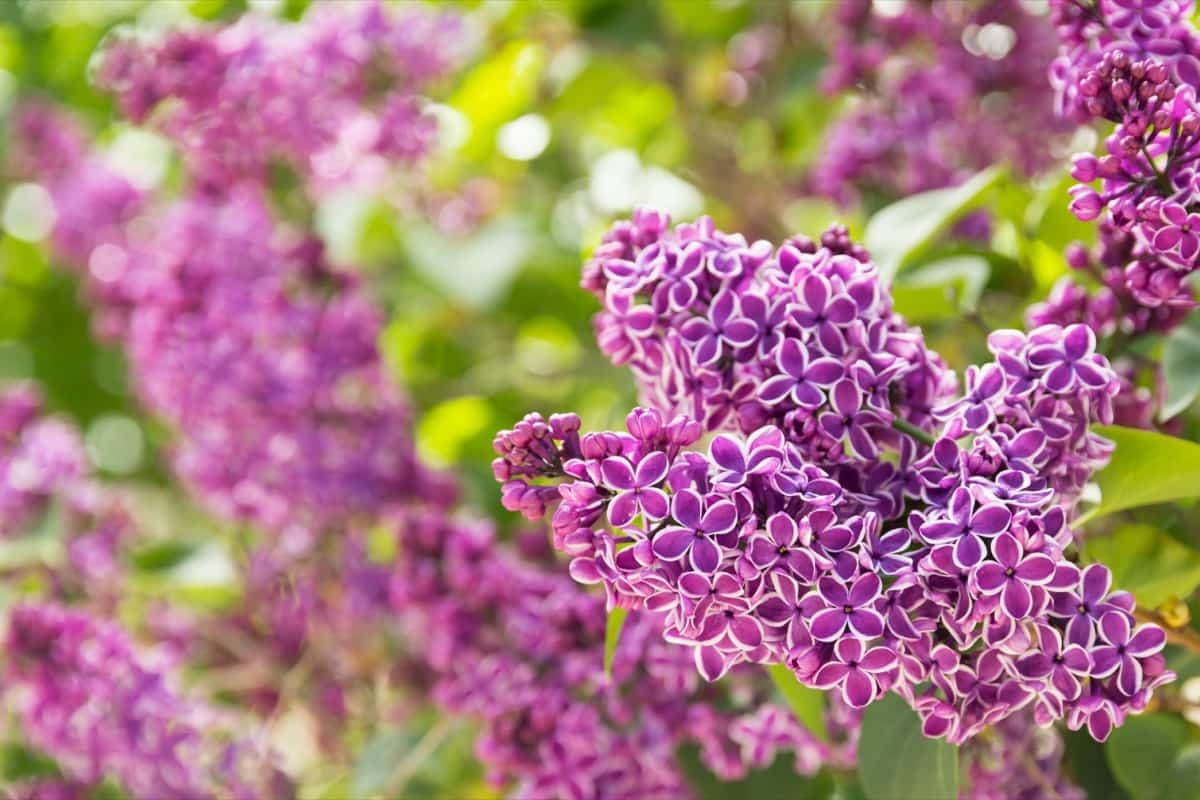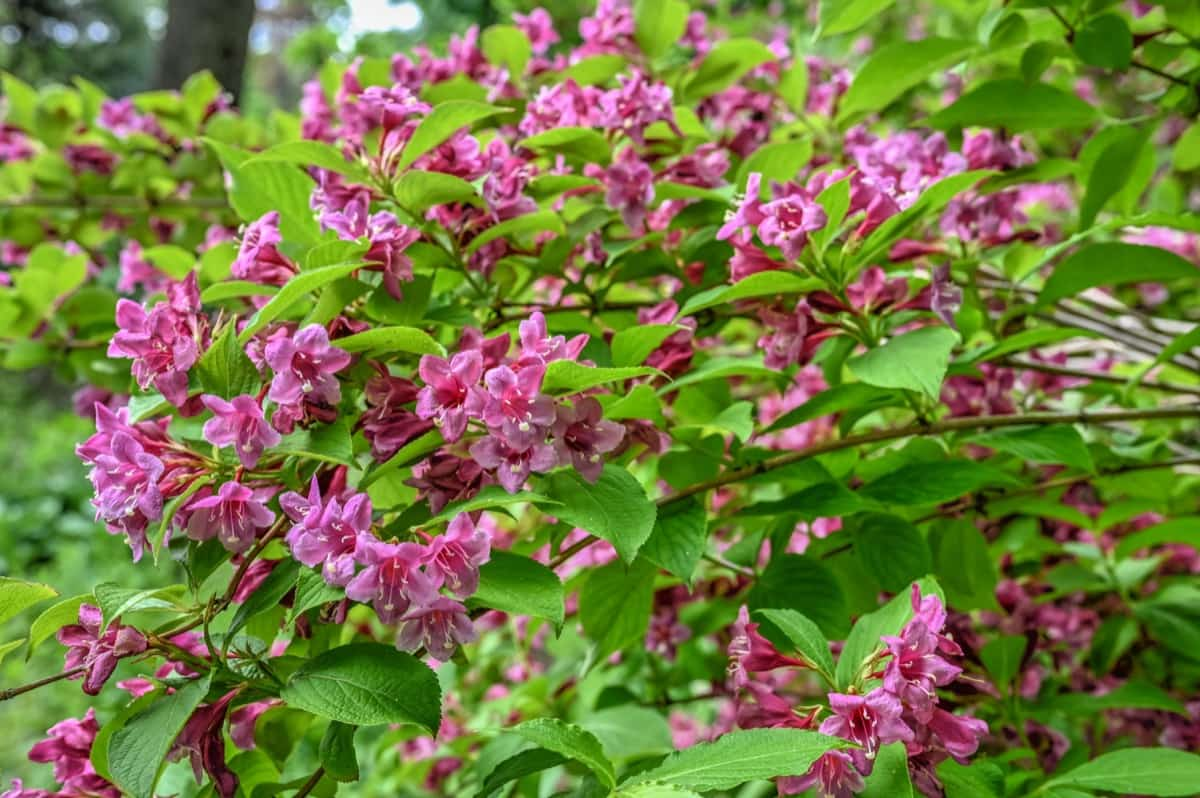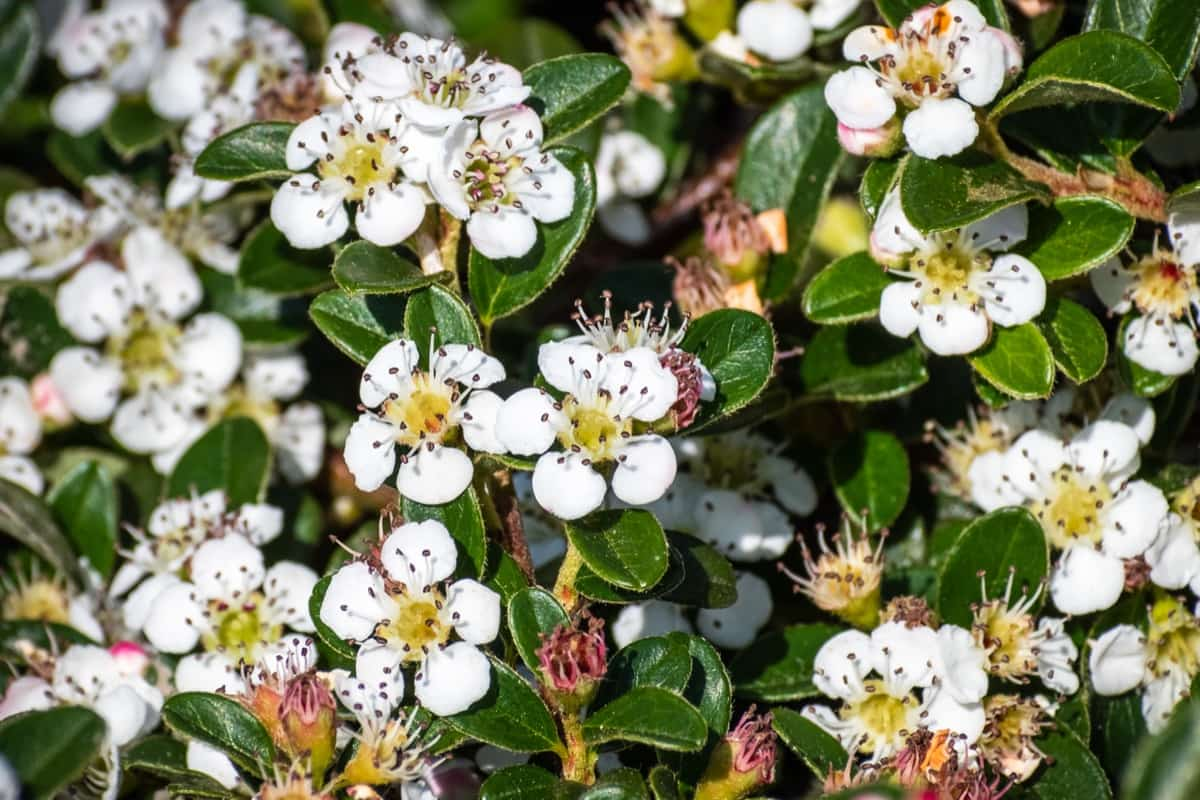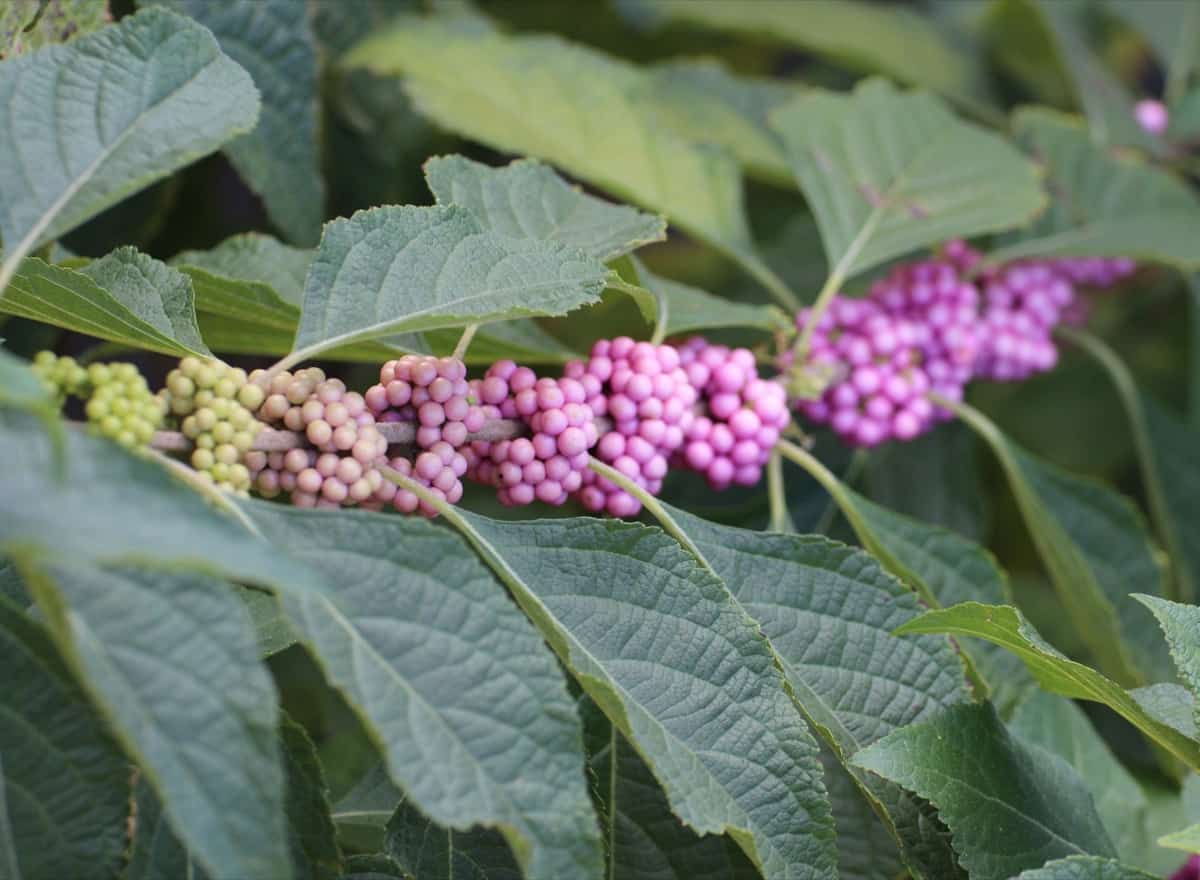Pollinators play a crucial role in our ecosystem, yet many of us may not fully realize their importance. These amazing creatures, including bees, butterflies, birds, and bats, are responsible for pollinating plants that produce fruits, vegetables, and nuts. The pollination process is essential for plant reproduction and the production of seeds.
Without it, many plant species would struggle to survive or even become extinct. Additionally, pollinators help maintain biodiversity by promoting genetic diversity within plant populations. Not only do pollinators benefit plants, but they also contribute to food production worldwide. Many crops depend on these tiny helpers for successful pollination and fruit or seed development.
14 Best Shrubs for Pollinators
Lilac
Lilacs are beloved for their stunning blooms and intoxicating fragrances. These shrubs come in various colors, including purple, pink, white, and even yellow. Their vibrant blossoms attract a range of pollinators, from bees to butterflies. Whether you choose a traditional Lilac or one of its unique cultivars, these shrubs will surely add beauty and charm to your garden. Plant Lilacs in well-draining soil with full sun exposure to ensure healthy growth and abundant blooms. Regular pruning will maintain their shape and encourage new growth.

Viburnum
Viburnum is a versatile and beautiful shrub that adds aesthetic appeal to your garden and attracts pollinators like bees and butterflies. With its clusters of fragrant flowers, Viburnum creates a captivating display in springtime. The Leatherleaf Viburnum is ideal for those interested in creating privacy or adding structure to their landscape. Its large, glossy leaves make it stand out among other shrubs.
Russian Sage
Russian Sage is a stunning shrub that adds beauty to your garden and attracts pollinators. With its silvery-gray foliage and tall, spiky purple flowers, it’s no wonder why this plant is a favorite among gardeners. One of the great things about Russian Sage is its ability to thrive in various soil types and climates. This shrub can handle it all whether you have sandy or clay soil or live in a hot and dry region.
It’s also drought-tolerant once established, making it low-maintenance for those busy gardeners. In addition to its aesthetic appeal, Russian Sage is a magnet for pollinators. These pollinators are drawn to the nectar-rich flowers, which bloom from summer through fall. So not only will you enjoy the beautiful sight of these creatures fluttering around your garden, but you’ll also be helping support their populations.
Butterfly Bush
The Butterfly Bush is a popular shrub for attracting pollinators with its vibrant and fragrant flowers. This eye-catching plant has become a favorite among gardeners for its ability to draw in butterflies, bees, and hummingbirds. With its long clusters of colorful blooms, the Butterfly Bush creates a stunning display in any garden or landscape. The flowers are available in shades of purple, pink, white, and yellow.
Their sweet fragrance fills the air and adds an enchanting touch to outdoor spaces. The Butterfly Bush is important in supporting pollinators. Butterflies are particularly fond of this shrub because it provides a rich nectar source. Bees and hummingbirds also benefit from the abundant food supply offered by this flowering beauty. Another advantage of planting Butterfly Bushes is its low-maintenance nature. This hardy shrub is drought-tolerant once established and requires minimal pruning.
Weigela
Weigela is a beautiful shrub that adds vibrant color to any garden. This plant is a favorite among gardeners with its trumpet-shaped flowers and attractive foliage. One of the great things about Weigela is its versatility. It comes in various colors, including shades of pink, red, and white, so you can choose the one that best complements your garden aesthetic.
In case you missed it: 15 Best Shade Loving Shrubs to Grow in Your Garden

Not only does Weigela provide visual appeal, but it also attracts pollinators with its nectar-rich blooms. This makes it an excellent choice for those who want to create a welcoming habitat for these important creatures. In terms of care, Weigela is relatively low maintenance. It grows well in full sun or partial shade and well-drained soil. Regular watering and occasional pruning will help keep the plant healthy and promote optimal blooming.
Spirea
Spirea is a lovely shrub that adds beauty and charm to any garden. With its delicate clusters of flowers in shades of white, pink, or red, it is sure to attract the attention of pollinators like butterflies and bees. One of the great things about Spirea is its versatility. It comes in various sizes, from compact varieties perfect for smaller gardens or containers to larger ones that can be used as hedges or borders. No matter what size you choose, Spirea always brings beauty and grace to your outdoor space.
In addition to being visually appealing, Spirea offers pollinators many benefits. Its nectar-rich flowers provide an abundant food source for bees and butterflies, helping to support their populations. The dense foliage of Spirea also provides shelter and nesting sites for birds. Another advantage of Spirea is its low-maintenance nature. Once established, it requires minimal care –regular watering and pruning to maintain its shape. This makes it ideal for busy gardeners who want a plant that will thrive with little effort.
Cotoneaster
Cotoneaster is a versatile shrub that attracts pollinators. With its delicate white or pink flowers and glossy green leaves, it’s no wonder why bees and butterflies are drawn to this plant. One of the great things about Cotoneaster is its ability to adapt to different growing conditions. Whether you have full sun or partial shade, this shrub will thrive. It can also tolerate various soil types, so you don’t have to worry too much about the quality of your soil.
In case you missed it: How to Choose Shrubs for Landscaping: A Beginners Guide

In addition to attracting pollinators, Cotoneaster provides birds with food and shelter. Its small red berries are highly sought after by many bird species, making it an excellent choice if you want to create a wildlife-friendly garden. Another advantage of Cotoneaster is its low-maintenance nature. Once established, it requires minimal pruning and watering. This makes it perfect for busy gardeners who want a beautiful landscape without spending hours on upkeep.
Summersweet
Summersweet is a beautiful shrub that attracts pollinators with its sweet fragrance and nectar-rich flowers. This deciduous shrub thrives in moist soil and partial shade. One of the main attractions of Summersweet is its unique and captivating scent. The flowers release a delightful aroma that fills the air during summer, making them a favorite among gardeners and bees. The blooms of Summersweet not only attract bees but also butterflies and hummingbirds.
These pollinators are essential for maintaining biodiversity and ensuring the reproduction of many plant species. By planting Summersweet in your yard, you’re providing these important creatures with a valuable food source. Furthermore, Summersweet was relatively low maintenance once established. It tolerates different soil conditions and can withstand periods of drought once its root system is well-established. This makes it ideal for those who want a beautiful flowering shrub without too much fuss.
Beautyberry
Beautyberry is a stunning shrub that adds beauty and attracts pollinators like bees and butterflies. With its vibrant purple berries, this plant will surely catch the eye of anyone. One of the great things about Beautyberry is its ability to thrive in various soil conditions. This shrub can adapt and produce abundant berries whether you have sandy or clay soil. Plus, it’s low maintenance, making it a perfect choice for busy gardeners.
In case you missed it: 16 Best Evergreen Flowering Shrubs for Hedges

The berries add visual interest and serve as a valuable food source for wildlife during the colder months. When it comes to planting Beautyberry, make sure to choose a sunny place in your garden with well-drained soil. Regular pruning will help maintain its shape and promote new growth.
Bluebeard
Bluebeard is a stunning shrub that can add beauty and charm to any garden. Bluebeard is visually appealing with its vibrant blue flowers and silvery-green foliage and attracts various pollinators. This shrub thrives in full sun and well-drained soil. It requires minimal maintenance once established, making it a perfect choice for busy gardeners. Bluebeard blooms from late summer into fall when many other plants are winding down, providing a burst of color when most needed.
But what makes Bluebeard truly special is its ability to attract butterflies and bees. These pollinators are essential for the reproduction of many plants and play a crucial role in maintaining biodiversity. You create a welcoming environment for these beneficial insects by including Bluebeard in your garden.
Forsythia
Forsythia is a beautiful shrub that bursts with vibrant yellow flowers in early spring. Its cheery blooms are a welcoming sight after the dullness of winter. This hardy shrub can tolerate various soil types and is relatively low maintenance, making it a popular choice for many gardeners. One of the standout features of Forsythia is its ability to attract pollinators.
In case you missed it: 16 Fragrant Spring-flowering Shrubs: How to Grow, Planting, and Care

Another advantage of Forsythia is its versatility in landscaping. It can be grown as a standalone shrub or used as part of a hedge, providing privacy and adding visual interest to your outdoor space. Regarding care, Forsythia prefers full sun but can also tolerate partial shade. Regular pruning after flowering helps maintain its shape and promotes better flower production for the following year. This stunning shrub will continue to delight humans and pollinators for years with proper care.
Sweetspire
Sweetspire is a shrub that not only adds beauty to your garden but also attracts pollinators like bees and butterflies. With its delicate white flowers that bloom in summer, this shrub is a must-have for any nature lover. One of the great things about Sweetspire is its versatility. It can thrive in sun and shade, making it suitable for various garden settings. Whether you have a sunny backyard or a shady corner, Sweetspire will bring life to your space.
Another benefit of this shrub is its ability to tolerate different soil types, including clay and moist soil. This means you don’t have to worry about the condition of your soil; Sweetspire will adapt and flourish regardless. In addition to being attractive and adaptable, Sweetspire also provides numerous environmental benefits. Its flowers attract important pollinators like bees and butterflies, helping to support their populations. Furthermore, the dense foliage provides shelter for birds and other small animals.
Buttonbush
Buttonbush is a versatile shrub that adds beauty and attracts pollinators with its unique and intriguing flowers. The button-like appearance of the flowers gives the shrub its name, and they are known for their sweet fragrance. The blooms emerge mid-summer and continue through early fall, providing a valuable pollinator food source.
Not only does Buttonbush attract pollinators with its flowers, but it also provides a habitat for many beneficial insects. Its dense growth habit creates sheltered areas where insects can nest and seek refuge from predators. In addition to being attractive to pollinators, Buttonbush is also an excellent choice for erosion control due to its deep root system.
Ninebark
Ninebark is a versatile and beautiful shrub that deserves a spot in any pollinator garden. With its attractive foliage, stunning flowers, and ability to attract bees and butterflies, it is a must-have for anyone looking to create an inviting habitat for these important creatures. These blooms are magnets for bees, butterflies, and other pollinators who rely on nectar as a food source.
In case you missed it: Cool-season Plants for Pollinators: Vegetables, Flowers, Fruits, Shrubs, and Herbs

By planting this shrub in your garden, you can help support these important species. In addition to being attractive to pollinators, Ninebark is also relatively low maintenance. It can tolerate various soil conditions and is drought-tolerant once established. This makes it an excellent choice for busy gardeners or those who live in areas with inconsistent rainfall.
Conclusion
When selecting shrubs for pollinators, it’s crucial to consider factors like bloom time, nectar production, and native species. Creating a welcoming environment for pollinators involves more than just planting shrubs. Landscaping with shrubs designed to attract pollinators adds beauty to your garden and contributes to environmental conservation. These plants enhance biodiversity by attracting other beneficial insects and providing shelter and food.
- Gardening Techniques in Planting Vegetables
- Where to Place Indoor Plants in Your Home
- How to Grow Tomatoes Organically at Home: A Comprehensive Guide
- Organic Gardening on a Budget: Low-Cost Methods and Materials
- Gongura Seed Germination and Planting Methods
- Cabbage Seed Germination and Selection
- Broccoli Seed Germination and Selection
- Asparagus Seed Germination and Variety Selection
- Seasonal Flower Gardening: Best Practices for Spring, Summer, Fall, and Winter
- How to Grow Hibiscus from Flower
- Plantation Ideas for Home Decoration: A Beginners Guide
- Flower Garden Designs and Layouts for Beginners
- Planting and Spacing Techniques in Papaya: A Beginner’s Guide
- Growing Gold: Essential Techniques for Planting Pineapples
- How to Make Kalanchoe Plant Bushy: Home Remedies and Solutions
- 11 Reasons Why Your Gardenia is Not Blooming: Home Remedies and Solutions
- Eco Elegance: The Guide to Designing a Drought-Tolerant Landscape
- Gardening on a Slope: Strategies for Hillside Landscaping
- Nourish and Flourish: Top Organic Mulches for Thriving House Plants
- Everything You Want to Know about Indian Mogra Flower: Discover Uses and Growing
- Green Thumb Success: Expert Tips for Cultivating Greenhouse Pumpkins All Year Round
- Maximize Growth & Flavor: The Ultimate Guide to Companion Planting in Herb Gardens
- How to Control Rhododendron Problems Naturally: Home Remedies and Organic Ways to Fix Them
- Natural Magic: The Remarkable Benefits of Cinnamon for Plants
- Best Steps to Revive Dying Tulip with Natural and Organic Treatment
- 10 Reasons Why Your Angel Trumpet is Not Blooming: Remedies and Treatment
- How to Fix Periwinkle Leaf and Flower-Related Problems: Natural Remedies and Solutions
- How to Fix Zinnias Leaf and Flower Problems: Discover Natural and Home Remedies
- Organic Steps to Induce Lemon Tree Flowers: A Comprehensive Guide
- Bloom Booster: Crafting the Perfect Homemade Bougainvillea Fertilizer
- Optimizing Growth: A Guide to Applying NPK Fertilizer for Potted Plants
- 10 Best Homemade Fertilizers for Rubber Plant: DIY Recipes and Application Method
- How to Boost Female Pumpkin Flowers: Effective Steps for More Flowers and High Yields
- Transform Your Indoor Garden: Top Benefits of Pink Salt for Houseplants
- 10 Best Homemade Fertilizers for Peacock Plants (Calathea): Easy DIY Guide
- Unlock Blooms: 9 Reasons Why Your Potted Chrysanthemum is Not Blooming